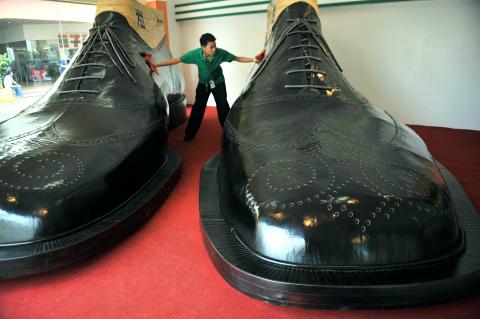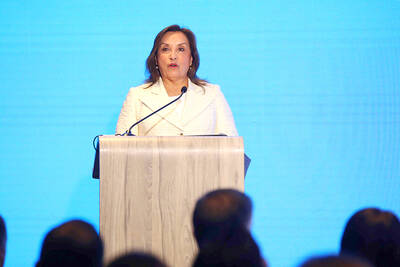A museum displaying the famed shoe collection of ex-first lady Imelda Marcos has reopened in the Philippines, heralding a fightback by its beleaguered shoe industry against a flood of cheap imports.
The museum is not just a showcase of the best of Marcos’ 3,000-pair collection, but also of the craftsmanship in shoe-making in the riverside eastern suburb of Marikina where the industry was born over a century ago.
Footwear consultant Tessie Endriga said that Marcos failed to provide the Marikina shoe industry with much-needed infrastructure or financing when her husband was in power. However, she did help in her own way.

Photo: AFP
“She did patronize local brands. If she liked a certain style, she would buy a dozen pairs,” said Endriga, who has worked with the government’s Bureau of Product Standards.
Marikina shoes were once famous, until low-priced footwear from countries like China and Vietnam flooded the industry over the years, local business leader Jose Tayawa said.
“You buy Marikina-made shoes and use them for five years. You buy Chinese shoes for one-fifth the price, but you can only use them for a few months,” said Tayawa, the head of the Marikina Chamber of Commerce and Industry.
Former shoe museum curator Dolly Borlongan conceded that most of Marcos’ shoes were imported, but added that there are many Marikina shoes among them, as well as displays on Marikina’s shoe-making history.
The museum was set up in 1998 as just one more way for Marikina to advertise its century-long history of making footwear, from humble slippers to rugged work boots to high-fashion custom shoes.
The town has also built the world’s largest shoes — a pair of leather men’s shoes, each as large as a van — which are still on display at a Marikina mall.
Generations of Filipinos grew up wearing the local products, and Marikina-made snake-skin shoes became the toast of Manhattan’s Fifth Avenue in the early-1980s, the city boasts on its Web site.
However, Marikina’s shoe--makers — and the shoe museum — have suffered setbacks in recent years. Massive flooding from Tropical Storm Ketsana last year damaged the museum, as well as many shoe-makers’ facilities and inventory.
The storm and the foreign competition took their toll. From the mid-1990s peak of 3,000, only about 200 Marikina shoemaking factories remain, said Roger Py, director-general of the Philippine Footwear Federation.
However, late last month, the museum reopened, just one of the moves that Marikina officials and businessmen hope will turn the footwear industry around, city administrator Victoriano Sabiniano said.
Tourists who visited the museum tended to look for a place to buy Marikina shoes, officials said, so the city is setting up a permanent shoe expo in a central area to sell its key product and spread the word about its quality.
“Step one is the local market. Once we fix that, we can go abroad,” Sabiniano said.
Quality was never the problem, Endriga said.
“We have come up with excellent shoes. The quality of craftsmanship in the Philippines can compete with Italy,” she said.
However, “I won’t say the shoe industry is dying, but it is missing out on a lot of opportunities,” she said.
Government figures show that Philippine footwear exports last year dropped 19.5 percent over the previous year to US$25.96 million.
Exports hit their peak at US$176.3 million in 1994, but have fallen sharply over the years.
Many visiting foreign buyers are still impressed by the quality of Philippine footwear, said Merlinda Diaz, an officer in the government’s Bureau of Export Trade Promotion.
“But then they ask for China-level prices and the deal falls through,” Diaz said.
The solution is not to compete with the high-volume production of these countries, he said.
“We avoid meeting the competition head-on in the cheap footwear sector. We go for the middle and the high-end,” said Py, who also heads Stefano Footwear, a major local manufacturer.
The local cobblers are now targeting smaller boutique stores in developed countries, where low prices are not the main attraction, he said.
The rising wages in China are also making Marikina shoes more competitive, Py added.

GROWING CONCERN: Some senior Trump administration officials opposed the UAE expansion over fears that another TSMC project could jeopardize its US investment Taiwan Semiconductor Manufacturing Co (TSMC, 台積電) is evaluating building an advanced production facility in the United Arab Emirates (UAE) and has discussed the possibility with officials in US President Donald Trump’s administration, people familiar with the matter said, in a potentially major bet on the Middle East that would only come to fruition with Washington’s approval. The company has had multiple meetings in the past few months with US Special Envoy to the Middle East Steve Witkoff and officials from MGX, an influential investment vehicle overseen by the UAE president’s brother, the people said. The conversations are a continuation of talks that

With an approval rating of just two percent, Peruvian President Dina Boluarte might be the world’s most unpopular leader, according to pollsters. Protests greeted her rise to power 29 months ago, and have marked her entire term — joined by assorted scandals, investigations, controversies and a surge in gang violence. The 63-year-old is the target of a dozen probes, including for her alleged failure to declare gifts of luxury jewels and watches, a scandal inevitably dubbed “Rolexgate.” She is also under the microscope for a two-week undeclared absence for nose surgery — which she insists was medical, not cosmetic — and is

Nintendo Co hopes to match the runaway success of the Switch when its leveled-up new console hits shelves on Thursday, with strong early sales expected despite the gadget’s high price. Featuring a bigger screen and more processing power, the Switch 2 is an upgrade to its predecessor, which has sold 152 million units since launching in 2017 — making it the third-best-selling video game console of all time. However, despite buzz among fans and robust demand for pre-orders, headwinds for Nintendo include uncertainty over US trade tariffs and whether enough people are willing to shell out. The Switch 2 “is priced relatively high”

Alchip Technologies Ltd (世芯), an application-specific integrated circuit (ASIC) designer specializing in artificial-intelligence (AI) chips, yesterday said that small-volume production of 3-nanometer (nm) chips for a key customer is on track to start by the end of this year, dismissing speculation about delays in producing advanced chips. As Alchip is transitioning from 7-nanometer and 5-nanometer process technology to 3 nanometers, investors and shareholders have been closely monitoring whether the company is navigating through such transition smoothly. “We are proceeding well in [building] this generation [of chips]. It appears to me that no revision will be required. We have achieved success in designing